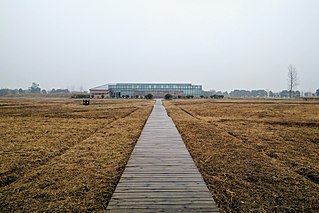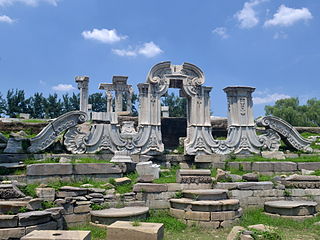 W
WThe national archaeological park of China is a designation created by the State Administration of Cultural Heritage (SACH) in 2009 to preserve and present large-scale archaeological sites. National archaeological parks must have previously been designated as Major Historical and Cultural Sites Protected at the National Level, and are considered to have high historical, cultural, and academic value. They include ancient settlements, cities and towns, palaces, temples and caves, engineering and manufacturing sites, and mausoleums and cemeteries. Many parks also have on-site museums.
 W
WThe Capital Cities and Tombs of the Ancient Koguryo Kingdom is a UNESCO World Heritage Site which includes a number of archaeological sites currently in Ji'an, Jilin Province and Huanren, Liaoning Province in Northeast China. (Goguryeo, was an ancient Korean kingdom located in what is now Northeast China and the northern Korean Peninsula.
 W
WThe Tongguan Kiln, also called the Changsha Kiln, is located in Wazhaping (瓦渣坪), Tongguan Subdistrict, Changsha, Hunan, China. It is one of the major kiln sites in Tongguan to be protected at the national level. The place was a historical kiln site of potteries in the Tang and Five Dynasties periods.
 W
WChengtoushan was a Neolithic settlement located on the northwestern edge of Dongting Lake in Li County, Hunan, China.
 W
WChengziya, also spelled Chengziyai, is a Chinese archaeological site and the location of the first discovery of the neolithic Longshan culture in 1928. The discovery of the Longshan culture at Chengziya was a significant step towards understanding the origins of Chinese civilization. Chengziya remains the largest prehistorical settlement found to date. The site is located in Shandong province, about 25 kilometres (16 mi) to the east of the provincial capital Jinan. It is protected and made accessible by the Chengziya Ruins Museum.
 W
WThe Daming Palace was the imperial palace complex of the Tang dynasty, located in its capital Chang'an. It served as the imperial residence of the Tang emperors for more than 220 years. Today, it is designated as a national heritage site of China. The area is located northeast of present-day Xi'an, Shaanxi Province.
 W
WThe Diaoyucheng, or Diaoyu Fortress, is located on the Diaoyu Mountain in Heyang Town, Hechuan District, Chongqing, is known for its resistance to the Mongol armies in the latter half of the Song dynasty. The death of Mongol leader Möngke Khan during the siege of Diaoyucheng resulted in the immediate withdrawal of Mongol troops from Syria and East Asia.
 W
WThe Han Yang Ling, or the Yang Mausoleum of Han, is the mausoleum of Emperor Jing, the sixth emperor of the Western Han Dynasty and his Empress Wang. The mausoleum complex is located in the Weicheng district of the City of Xianyang, Shaanxi Province, on the northern bank of the Wei River and about 20 km to the north of the city center of the provincial capital of Xi’an.
 W
WJinsha is an archaeological site in Chengdu, capital of China's Sichuan Province. The site is located in Qingyang District, along the Modi River (摸底河). It is named for a nearby street, itself named after the Jinsha River.
 W
WThe Mausoleum of the First Qin Emperor is located in Lintong District, Xi'an, Shaanxi province of China. This mausoleum was constructed over 38 years, from 246 to 208 BC, and is situated underneath a 76-meter-tall tomb mound shaped like a truncated pyramid. The layout of the mausoleum is modeled on the Qin capital Xianyang, divided into inner and outer cities. The circumference of the inner city is 2.5 km and the outer is 6.3 km. The tomb is located in the southwest of the inner city and faces east. The main tomb chamber housing the coffin and burial artifacts is the core of the architectural complex of the mausoleum.
 W
WNiuheliang is a Neolithic archaeological site in Liaoning Province, Northeast China, along the middle and upper reaches of the Laoha River and the Yingjin River. Discovered in 1983, Niuheliang site belongs to the Hongshan culture. It includes evidence of religion, such as a temple, an altar and a cairn.
 W
WThe Old Summer Palace, known in Chinese as Yuanming Yuan, and originally called the Imperial Gardens, was a complex of palaces and gardens in present-day Haidian District, Beijing, China. It is 8 kilometres (5.0 mi) northwest of the walls of the former Imperial City section of Beijing. Constructed throughout the 18th and early 19th centuries, the Old Summer Palace was the main imperial residence of Qianlong Emperor of the Qing dynasty and his successors, and where they handled state affairs; the Forbidden City was used for formal ceremonies. Widely perceived as the pinnacle work of Chinese imperial garden and palace design, the Old Summer Palace was known for its extensive collection of gardens, its building architecture and numerous art and historical treasures. It was reputed as the "Garden of Gardens" in its heyday.
 W
WPanlongcheng or Panlong City is an archaeological site associated with the Erligang culture during the Shang dynasty period. The site is located just north of the Yangtze river, on the bank of the Panlong lake, and is surrounded by the Fushui river in Huangpi, Wuhan, Hubei, China. Panlongcheng is the largest excavated Erligang site, showing the southernmost reach of the Erligang culture at its peak. It was discovered in 1954, and excavated in 1974 and 1976.
 W
WSanxingdui is the name of an archaeological site and a major Bronze Age culture in modern Guanghan, Sichuan, China. Largely discovered in 1986, following a preliminary finding in 1929, archaeologists excavated remarkable artifacts that radiocarbon dating placed in the 12th–11th centuries BCE. The type site for the Sanxingdui culture that produced these artifacts, archeologists have identified the locale with the ancient kingdom of Shu. The artifacts are displayed in the Sanxingdui Museum located near the city of Guanghan.
 W
WThe Shanglin Lake Yue Kilns are a cluster of archaeological sites where Yue ware was made, though they are by no means the only ones. They are located near Shanglin Lake, in Cixi City, Zhejiang, China. The kilns produced celadon around the Shanglin Lake area during the Tang, Han, and Song dynasties are referred to as such. A variety of different wares were manufactured during the kilns' history, including "jars, spittoons, wine pots, incense burners, cups, bowls, flasks, cases, writing-brush basins, dishes, handle-less cups, pots, wine cups, flat bowls, basins", and children's toys.
 W
WThe Weiyang Palace was the main imperial palace complex of the Han dynasty and numerous other Chinese dynasties, located in the city of Chang'an. It was built in 200 BC at the request of the Emperor Gaozu of Han, under the supervision of his prime minister Xiao He. It served as the administrative centre and imperial residence of the Western Han, the Xin dynasty, the Eastern Han, the Western Jin, the Han Zhao, the Former Qin, the Later Qin, the Western Wei, the Northern Zhou, and the early Sui dynasty.
 W
WOccupying an area of some 50 km2 (19 sq mi), the Western Xia mausoleums at the foot of the Helan Mountains in the Ningxia Hui Autonomous Region of northwestern China includes nine imperial mausoleums and 250 tombs of imperial relatives and officials. This burial complex lies some 40 km (25 mi) westward from capital city of the Western Xia, the Xingqing fu or Xingqing, what is modern-day Yinchuan, capital of the Ningxia Hui Autonomous Region.
 W
WYinxu is the site of one of the ancient and major historical capitals of China. It is the source of the archeological discovery of oracle bones and oracle bone script, which resulted in the identification of the earliest known Chinese writing. The archeological remnants known as Yinxu represent the ancient city of Yin, the last capital of China's Shang dynasty which existed through eight generations for 255 years, and through the reign of 12 kings. Yinxu was discovered, or rediscovered, in 1899. It is now one of China's oldest and largest archeological sites, and has been selected as a UNESCO World Heritage Site. Yinxu is located in northernmost Henan province near the modern city of Anyang, and near the Hebei and Shanxi province borders. Public access to the site is permitted.
 W
WZengpiyan is a Neolithic cave site in southern China. It is located in the Guilin region on the south-western fringes of the Dushan Mountain in the autonomous region Guangxi and is considered to be one of the most important cave sites of the Neolithic in China as it is one of the many independent centers for the introduction of animal domestication and pottery.
 W
WZhoukoudian Peking Man Site (周口店北京人遗址), also romanized as Choukoutien, is a cave system in suburban Fangshan District, Beijing. It has yielded many archaeological discoveries, including one of the first specimens of Homo erectus, dubbed Peking Man, and a fine assemblage of bones of the gigantic hyena Pachycrocuta brevirostris.